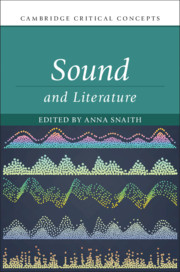Book contents
- Sound and Literature
- Cambridge Critical Concepts
- Sound and Literature
- Copyright page
- Epigraph
- Contents
- Figures
- Contributors
- Acknowledgements
- Introduction
- Part I Origins
- Part II Development
- Part III Applications
- Chapter 10 What We Talk about When We Talk about Talking Books
- Chapter 11 Prose Sense and Its Soundings
- Chapter 12 Dissonant Prosody
- Chapter 13 Deafness and Sound
- Chapter 14 Vibrations
- Chapter 15 Feminism and Sound
- Chapter 16 Wireless Imaginations
- Chapter 17 Attending to Theatre Sound Studies and Complicité’s The Encounter
- Chapter 18 Bob Dylan and Sound: A Tale of the Recording Era
- Bibliography
- Index
Chapter 11 - Prose Sense and Its Soundings
from Part III - Applications
Published online by Cambridge University Press: 29 May 2020
- Sound and Literature
- Cambridge Critical Concepts
- Sound and Literature
- Copyright page
- Epigraph
- Contents
- Figures
- Contributors
- Acknowledgements
- Introduction
- Part I Origins
- Part II Development
- Part III Applications
- Chapter 10 What We Talk about When We Talk about Talking Books
- Chapter 11 Prose Sense and Its Soundings
- Chapter 12 Dissonant Prosody
- Chapter 13 Deafness and Sound
- Chapter 14 Vibrations
- Chapter 15 Feminism and Sound
- Chapter 16 Wireless Imaginations
- Chapter 17 Attending to Theatre Sound Studies and Complicité’s The Encounter
- Chapter 18 Bob Dylan and Sound: A Tale of the Recording Era
- Bibliography
- Index
Summary
Oriented by theoretical work form C. S. Peirce and Walter Ong through conceptual poet John Cayley, from John Stuart Mill on poetry as ‘overheard’ to Steven Connor on the ‘white voice’ of silent enunciation – as well as, in contrast, by book sculpture in the conceptual mode of the bibliobjet, closed to all reading – this essay lends intensive granular audition to passages from Dickens through Virginia Woolf to Toni Morrison. Its effort is to register, and further to generalise, the phonemic dimension of what, loosely but famously called ‘secret prose’ in Dickens by Graham Greene, I will be identifying (after Ong’s ‘secondary orality’) as the ‘secondary vocality’ of the reading event in cases of uniquely impacted audiovisual overlap identified as ‘graphonic’ wording.
Keywords
- Type
- Chapter
- Information
- Sound and Literature , pp. 234 - 251Publisher: Cambridge University PressPrint publication year: 2020

